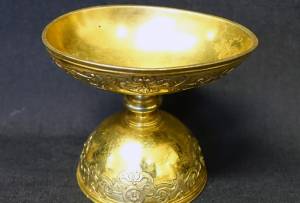
A happy Easter from Waddesdon
As Waddesdon prepares to welcome visitors back, we take a look at a selection of objects from the collection which evoke this time of year
Easter is a time of hope, new life and new beginnings – themes which this year carry particular resonance. Spring too promises brighter times: as the days become warmer nature rejuvenates and brings fresh optimism. The gardens are coming to life. Drifts of daffodils, crocus, scilla and tulips bring splashes of colour and birdsong fills the air around the Aviary.

From the gilt-bronze case of this clock, composed of rocky outcrops and leafy forms, spring bountiful bright blooms of Vincennes porcelain. The Meissen figure with a sheep at her feet, probably modelled by Johann Kändler, collects flowers in her dress. Vincennes specialised in the production of porcelain flowers used to decorate clocks, wall lights and chandeliers. Madame de Pompadour, official mistress to Louis XV, placed scented examples in the flowerbeds at her château at Bellevue for the king’s visit in 1750.

This almost life-size group of a nanny goat suckling her kid was made for the never-completed porcelain menagerie in the Japanese Palace of Augustus the Strong, King of Poland and Elector of Saxony (b.1670, d.1733). Over 60 different animals were modelled for this eccentric and experimental scheme, many from real life. Some were additionally cold painted after firing, adding to the sense of naturalism.

This silver-gilt egg cup forms part of an extravagant 18th-century travelling tea service containing both objects made from gilded silver and Meissen porcelain, including cups, saucers and a teapot. Made by the goldsmith Johann Engelbrecht, the egg cup can be used either way up, with the boiled egg eaten either conventionally, or lying on its side. This may seem peculiar to modern eyes, this method remained popular in Germany until the 19th century. The set also includes a combined bone marrow scoop (considered a delicacy) and egg spoon.

Decorated with a vivid turquoise blue ground (bleu céleste) and painted reserves depicting cupids, this sinuous flower vase was designed to hold fragrant fresh flowers as well as imitations in porcelain. The rococo delighted in bringing the natural world indoors.

This comical and unappetising trade label of the confectioner Lemoine advertises chocolate drops under the name ‘rabbit droppings’. It promotes his position as supplier to Louise de Bourbon, Duchess of Orléans – mother of Louis Philippe, the last king of France.

The naturalistic floral marquetry of this chest-of-drawers was originally vibrantly coloured, echoing the full variety of colours found in nature.

The flowers, which include tulips, lilies, carnations, roses and springtime daffodils, are botanically accurate and are dyed using natural pigments and shaded in hot sand to give the illusion of depth. The bouquet is arranged in a simulated green marble urn.
Happy Easter from all at Waddesdon and we look forward to welcoming you back soon.




